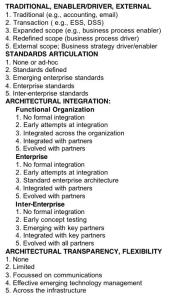There are numerous articles, studies and models to be found on the topic Business/IT-alignment. This makes it hard to define which model is most adequate to use. But some models are apparently much more accepted than others, although there seems to be no consensus on the best one. The basis of many models seems to be the Strategic Alignment Model (SAM) of Henderson and Venkatraman [Henderson and Venkatraman, 1999]. This model suggests that IT-business alignment can be achieved by building linkages among four strategic domains:
The dimension of strategic fit differentiates between external focus, directed towards the business environment, and internal focus, directed towards administrative structures. The other dimension of functional integration separates business and IT. According to the authors, Strategic Alignment can only occur, when three of the four domains are in alignment.
According to Leonard [Leonard, 2008] the SAM-model merely describes what needs to be aligned. In the same study, Leonard points out that there has been far less consensus regarding how alignment is to be achieved. The model which is seen by Leonard as the model which gives insight in the processs by which alignment can be improved is the model of Luftman. This is more about the question how alignment is achieved. The theory of Luftman is found in many articles as a framework for assessing Alignment within a company, and looks very useful.
Luftman developed a maturity assessment model, based on the 12 elements of Business/IT-Alignment, which can be recognized in the model of Henderson and Venkatraman. The components of this model, in concert with the earlier enables/inhibitors research [Luftman and Brier, 1999], form the building blocks for the strategic alignment maturity assessment method [Luftman, 2000].
This model can be used in a survey to see where a company stands regarding maturity and once this maturity is understood, it can provide the organisation with a roadmap that identifies opportunities for enhancing the harmonious relationship of business and IT [Luftman, 2000]. The model consists of 6 alignment areas. Each area has multiple attributes. For each area there are clearly defined maturity levels. All areas should be given attention to mature the alignment between business and IT.

The areas are:
Communications
How well does the technical and business staff understand each other? Do they connect easily and frequently? Does the company communicate effectively with consultants, vendors and partners? Does it disseminate organizational learning internally?
Competency/Value Measurement
How well does the company measure its own performance and the value of its projects? After projects are completed, do they evaluate what went right and what went wrong? Do they improve the internal processes so that the next project will be better?
Governance
Do the projects that are undertaken flow from an understanding of the business strategy? Do they support that strategy?
Partnership
To what extend have business and IT departments forged true partnerships based on mutual trust and sharing risks and rewards?
Scope & Architecture
To what extend has technology evolved to become more than just business support? How has it helped the business to grow, compete and profit?
Skills
Does the staff have the skills needed to be effective? How well does the technical staff understand business drivers and speak the language of the business? How well does the business staff understand relevant technology concepts?
 In my experience, the assessment-method of Luftman really provides enterprises and organisations with a tool which gives insights in the business/it-relationship. It is very useful in defining improvement areas, and even more important, it facilitates an open discussion with executives from business and IT. What it doesn’t, is providing guidelines how to improve the alignment between business and IT. But, the six dimensions cover, in my experience, quite nice on which elements attention should be given. Not at one specific, but all dimensions should be in harmony. I will come back to these dimensions in following posts.
In my experience, the assessment-method of Luftman really provides enterprises and organisations with a tool which gives insights in the business/it-relationship. It is very useful in defining improvement areas, and even more important, it facilitates an open discussion with executives from business and IT. What it doesn’t, is providing guidelines how to improve the alignment between business and IT. But, the six dimensions cover, in my experience, quite nice on which elements attention should be given. Not at one specific, but all dimensions should be in harmony. I will come back to these dimensions in following posts.
References
Henderson, J.C. and Venkatraman, N.:Strategic Alignment: Leveraging Information Technology for Transforming Organizations, IBM Systems Journal, 1999
Leonard, Jenny: What are we aligning? Implications of a Dynamic Approach to Alignment, 19th Australian Conference on Information Systems, Christchurch, 2008
Luftman, Jerry and Brier, Tom: Achieving and Sustaining Business-IT Alignment, Calirfornia Management Review, Fal 1999
Luftman, Jerry: Assessing Business-IT Alignment Maturity, Communications of AIS, Volume 4, Article 14, December 2000




